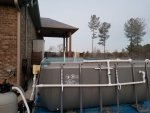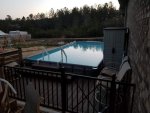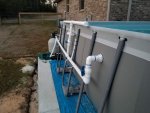Hello all, read on here a lot, but don't post much. So we are new to pools and I had no idea what bonding was until I hard plumbed a Hayward pump and read the requirement in the installation section.
Here is my dilemma:
We have an Intex 12x24x52 Ultra Frame pool sitting on a concrete pad that was built specifically for the pool by our contractor (brand new house). The concrete pad is perfectly level BUT it is not "wired" to bond as part of a pool system. Is it safer to bond SOME of the pool or NONE of the pool? I can bond the water with the skimmer lug and connect a copper wire to all the legs (if needed) but I cannot dig around the pool because 2 sides of the concrete pad are attached to back wall of the house and the side of the porch.
The pump is the 1.5 hp Matrix and it is plugged into a GFI.
Thanks for any advice!
Here is my dilemma:
We have an Intex 12x24x52 Ultra Frame pool sitting on a concrete pad that was built specifically for the pool by our contractor (brand new house). The concrete pad is perfectly level BUT it is not "wired" to bond as part of a pool system. Is it safer to bond SOME of the pool or NONE of the pool? I can bond the water with the skimmer lug and connect a copper wire to all the legs (if needed) but I cannot dig around the pool because 2 sides of the concrete pad are attached to back wall of the house and the side of the porch.
The pump is the 1.5 hp Matrix and it is plugged into a GFI.
Thanks for any advice!




